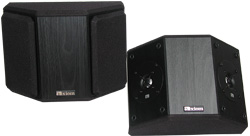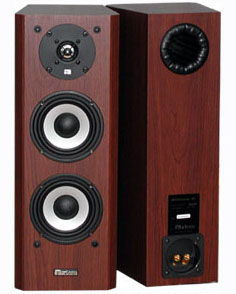|
|

|
|
Specifications:
Axiom M60ti
● Drivers: One 1" Tweeter, One
5-1/4" Midrange, Two 6-1/2" Woofers
● Max Amp Power 250 Watts
● Min Amp Power 10 Watts
● MFR: 37 Hz - 22 kHz ± 3 dB
● Sensitivity: 93 dB/W/M (In-Room)
● Nominal Impedance: 8 Ohms
● Dimensions: 37.5" H x 9.25" W x 15" D
● Weight 47 Pounds Each
● MSRP: $800/Pair USA in Black
Oak, Maple, Beech, and Cherry
Specs and prices for the other
models are included in the text.
Axiom Audio
www.axiomaudio.com
| |
Introduction
I approached this review in two separate ways. First off, I
love the opportunity to audition new speakers, especially ones that claim
superb performance at a budget price. Axiom Audio is a company from our
neighbors to the north, Canada. Completely skipping the retail route, they
are only available on the Internet.
The second part of this review is an evaluation of an idea in home
theater. See a lot of people swear that the holy grail of speaker setups
is a completely matched five speaker system and a powered subwoofer. I have
never had the opportunity to use five matched speakers in my setup until this point so I was anxious for the opportunity. I talked to Axiom
about this and they were thrilled with the idea of testing the theory in
my own setting. But they went the extra mile. Not only did they provide me
with five matched M60ti floor standing speakers, they also loaned me a pair of
their “quadpole surrounds” and a set of bookshelf monitors for the rear
channels. This way I can really get an idea of which combination I liked more.
Axiom uses the same Canadian research facility (the NRC) that many other high-end
speaker companies from the north have used including my personal favorite, PSB. This facility allows companies an unprecedented level of flexibility
when it comes to testing. Most companies can't afford to build their own
anechoic chambers for proper testing of speakers, so a lot of their
testing is either done in a quasi-anechoic way (i.e., test equipment that
uses processing to simulate anechoic results) or have to spend big bucks
to rent a chamber for testing which raises the price of the speakers. This
is a lot of the reason that companies like PSB, Axiom, and Paradigm (who
went on to build their own facility) can make such accurate speakers at
such a great price.
The Setup
My normal setup consists of PSB Image 6Ts for my mains. I have found
these to be excellent speakers both for music and film soundtracks. The
Axiom M60's are very similar in size and structure. Both feature a 1”
titanium tweeter and 6.5” woofers. But the M60 throws in a 5.25” midrange
driver instead of a third 6.5” woofer. The porting is also a bit
different. The Axioms feature two ports on the back of the speaker, whereas
the PSB's are ported on the front. Both speakers suffer from one of my
chief complaints with speakers nowadays though. They both have a slender
profile despite their height. This creates a bit of a top heavy cabinet
that makes the speakers easy to knock over, even with the provided spikes.
I think companies that use these slender cabinets should come up with a
wider base solution to eliminate the risk of toppling over.
The Sound
I was very impressed with the M60's both in music and movie soundtrack
performance. The speaker has excellent performance in the midrange which
is very important to me. The low end performance wasn't quite a match to
my PSB's though in terms of depth and control, but the PSB's feature a
third driver. This is not an issue if using this speaker with a
subwoofer, which is always recommended. I coupled the Axioms with my three SVS subs, and
they blended perfectly with a fixed crossover point of 80 Hz.
Some people get pretty bent about how well their towers perform in the
lower range, but this is not an issue with a good subwoofer.
One of the best things about these towers was their imaging, especially
with two channel listening. I could really get a great sense of where
the performers were in the soundstage. I used
selections from Nine Inch Nails, A Perfect Circle, and Staind. Not the
normal high end review selections but the material is excellent for
testing separation of instruments and depth of soundstage, especially the
Nine Inch Nails material.
The height of the tweeter was
a bit low for me, causing the soundstage to feel low at times, almost like
I was looking down on the performance. This was especially evident with
Big Phat Bands XXL DVD-A.
I also noticed some very slight resonance in the
cabinet when using low end test tones from AVIA. I never once noticed any
resonance problems when music was playing though.
Imaging was never an issue with movie soundtracks. In fact, this is where
the speaker performed its best in my opinion. Having three matched
speakers across the main soundstage creates a completely seamless
experience, and now that I have experienced it I will never have anything
else. The M60's were superb with dialogue in films and never gave off a
bloated feeling in the midrange that I have experienced with other
speakers. They did an excellent job of just blending into the
front room and never really calling attention to themselves with movies;
that is what I always look for.
I have heard complaints that Axiom speakers are too “bright”. I
wouldn't classify this at all with the M60. While the speaker remained
quite detailed in the higher frequencies, I would never have characterized
it as “bright” or “harsh”, even at higher listening levels.
 |
|
QS8 “Quadpole” Surrounds |
The QS8 surround ($470/pair) is
unlike any other surround speaker I have used in the past. They couple
two 1" tweeters in a bipole configuration on the front, along with two 5.25”
woofers, one each on the top and bottom of the enclosure. This produces a remarkable sound that was
the most spacious I have heard to date, although the design goes against
THX recommendations for a rear speaker setup.
The QS8s have
an uncanny ability to blend themselves into the rear soundstage and
only calling attention to themselves when needed. They did a far
better job of replicating the movie theater experience than any other
surround I have used before. They also did an exceptional job with
multi-channel music and really gave the room a depth it hasn't had before.
This was by far my favorite of the speakers they sent me, and I will be
REALLY sad to see them go.
 |
|
M22ti Bookshelf
Speaker |
The last speaker in the lineup is the M22. This is a rather
large bookshelf monitor that features two 5.25” woofers and one 1”
tweeter, selling for $400 a pair. They are 19.7" in height, compared to
the M60ti's height of 37.5". This complements the other speakers perfectly as it uses the same
drivers. I set these up for use as rear back
channels for 6.1 or 5.1 EX soundtracks. While they did a consistently
excellent job, I found the lack of EX movie titles a bit of a problem in
effectively evaluating the speakers. So I moved them up to the front to give them a try.
The M22's would make an excellent main speaker with a subwoofer
complimenting it. While it does a commendable job on its own, it just
doesn't have the range to work on its own. The image and detail were almost exactly the same as the M60, which was
expected given the similar attributes. The M60 easily surpassed it though
in the lower end detail and depth.
I have to admit that using the five matched speakers was nice for music,
but I found the rear towers just too directional for film soundtrack
reproduction. Panning effects were handled nicely, but the sense of space
normally associated with my dipolar surrounds was lost for the most part.
The rear speakers were about six feet from the listening position but
almost right against the wall. I think I may have felt differently given a
larger room.
I listened to a wide variety of music and film with the five matched
setup. The highlight of this was by far multi-channel music playback,
which consisted of both DVD-A and SACD titles. But again, there were
moments when I missed my old dipolar surrounds. Some multi-channel mixes
feature very discrete information in the surrounds and this was
complemented by the towers, but other tracks tend to use the rear
soundstage for depth and ambience, which benefited more from the dipolar
design in my opinion. There are receiver and processor solutions that
would help this by allowing the end user to select from different speakers
for playback. I know this is a very popular feature on some Denon
receivers.
When I eventually switched over to the quadpoles, which is more typical of
my normally listening system, the depth and ambience of the rear
soundstage was once again realized. This is by far the way to go for me. I
just love the sense of space this solution creates, making the room feel
far bigger then it really is.
Conclusions
I hope that this review helps readers who are on the fence about
which configuration would work best for them. Understand that room size is
pretty much the deciding factor. If you have ample space, then the matched
system may be your best bet, but medium sized rooms and smaller will
probably benefit from a dipolar or bipolar speaker.
The Axiom's were an absolute treat. They are a rare bargain that
offers excellent performance at a reasonable price point. Their “quadpole”
surrounds were the definite highlight for me with the amazing sense of
space they created. Axiom's speakers also have the plus of
including 2-day FedEx shipping in their price and a no hassle 30 day
audition. I think it would be a big mistake not to take advantage of the
audition if you are in the market for great speakers.
- Kris Deering -
Terms and Conditions of Use

|






